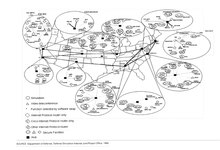79:
22:
141:
circuits, for an aggregate bandwidth of about 6 megabits/second. In 1994, DSI program management transitioned to a joint program office of DARPA and DISA, and after the network became fully operational in
February 1995, DARPA handed off all management responsibility to DISA.
161:
permanent virtual circuits. The Phase II topology was a mesh of 7 backbone nodes, with 46 tail circuits running to the other DSI sites as of April 1998. (See D. Sahu for a Phase II network map and extensive details.)
256:
171:
78:
188:"Emerging technologies - national/Defense Information Infrastructure and the Defense Information Systems Network", J.M. Pullen, D. Cohen, and D. Wood,
43:
111:
95:
65:
213:
133:
study in 1993 highlighted the importance of these capabilities in simulations, and by late 1994, the DSI connected about 100
154:
118:
251:
219:"Modeling Distributed Techniques for Synthetic Training Environments", D. B. Cavitt, C. M. Overstreet, K. J. Maly, in
36:
30:
158:
47:
231:"A Study of the Defense Simulation Internet (DSI) for the Joint Advanced Distributed Simulation (JADS) Project"
146:
126:
175:
130:
134:
224:
125:
with bandwidth guarantees that are essential to distributed interactive simulations via the
107:
181:"High-quality multimedia conferencing through a long-haul packet network", Chip Elliott,
230:
246:
99:
240:
150:
172:"Impact of Advanced Distributed Simulation on Readiness, Training and Prototyping"
138:
122:
199:, vol. 27, no. 3, Elsevier North-Holland, pages 387-394, December 1994.
149:. Phase II, completed in October 1997, was a reimplementation using
183:
Proceedings of the first ACM international conference on
Multimedia
145:
Phase I of the DSI was implemented by BBN T/20 routers running the
103:
77:
195:"Networking for Distributed Virtual Simulation", Mark Pullen,
110:
from about 1991-1995, after which time it was operated by the
15:
137:
at sites around the world. Many links operated at multiple
202:"Networking Technology and DIS", Mark Pullen and D. Wood,
178:
Task Force on
Simulation, Readiness and Prototyping, 1993.
94:) was a specialized, wide-area network created to support
257:History of telecommunications in the United States
206:, vol. 83, no. 8, pages 1156-1167, August 1995.
233:, Devaraj Sahu, Mitre Corporation, April 1998.
8:
210:Distributed Interactive Simulation of Combat
223:, edited by George Zobrist, Kallol Bagchi,
216:, DIANE Publishing Company, 1996, page 27.
197:Computer Networks and ISDN Systems Journal
66:Learn how and when to remove this message
29:This article includes a list of general
117:The DSI evolved from DARPA's earlier
7:
121:, which could provide the realtime
112:Defense Information Systems Agency
96:Distributed Interactive Simulation
35:it lacks sufficient corresponding
14:
82:Defense Simulation Internet, 1994
185:, August 2-6, 1993, pages 91-98.
20:
221:Advanced Computer System Design
214:Office of Technology Assessment
1:
155:Resource Reservation Protocol
227:, CRC Press, 1999, page 243.
119:Terrestrial Wideband Network
106:, and built and operated by
88:Defense Simulation Internet
273:
190:Proceedings of MILCOM '93
147:Internet Stream Protocol
127:Internet Stream Protocol
204:Proceedings of the IEEE
50:more precise citations.
192:, October 11-14, 1993.
102:. It was sponsored by
83:
176:Defense Science Board
131:Defense Science Board
81:
153:routers running the
135:local area networks
252:Wide area networks
84:
76:
75:
68:
264:
174:, Report of the
108:BBN Technologies
100:videoconferences
71:
64:
60:
57:
51:
46:this article by
37:inline citations
24:
23:
16:
272:
271:
267:
266:
265:
263:
262:
261:
237:
236:
168:
72:
61:
55:
52:
42:Please help to
41:
25:
21:
12:
11:
5:
270:
268:
260:
259:
254:
249:
239:
238:
235:
234:
228:
225:Kishor Trivedi
217:
207:
200:
193:
186:
179:
167:
164:
74:
73:
28:
26:
19:
13:
10:
9:
6:
4:
3:
2:
269:
258:
255:
253:
250:
248:
245:
244:
242:
232:
229:
226:
222:
218:
215:
211:
208:
205:
201:
198:
194:
191:
187:
184:
180:
177:
173:
170:
169:
165:
163:
160:
156:
152:
148:
143:
140:
136:
132:
128:
124:
120:
115:
113:
109:
105:
101:
97:
93:
89:
80:
70:
67:
59:
49:
45:
39:
38:
32:
27:
18:
17:
220:
209:
203:
196:
189:
182:
157:(RSVP) over
144:
116:
91:
87:
85:
62:
53:
34:
129:(ST-II). A
48:introducing
241:Categories
166:References
151:Cisco 7500
31:references
123:multicast
56:June 2019
114:(DISA).
44:improve
33:, but
247:DARPA
104:DARPA
98:and
86:The
159:ATM
92:DSI
243::
212:,
139:T1
90:(
69:)
63:(
58:)
54:(
40:.
Text is available under the Creative Commons Attribution-ShareAlike License. Additional terms may apply.
